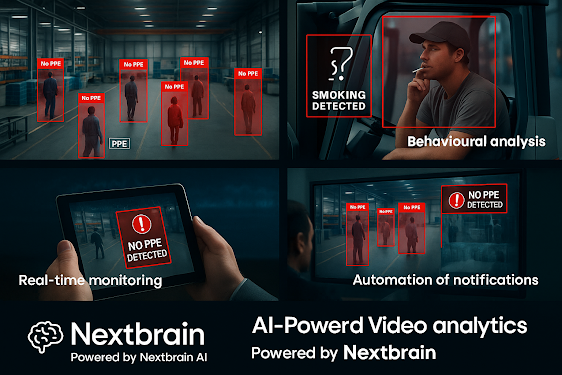How AI-Powered Video Analytics is Revolutionizing Logistics Safety
The logistics industry is the backbone of the global supply chain, ensuring the smooth movement of goods from manufacturers to consumers. However, with the rapid growth of e-commerce, rising shipment volumes, and increasing pressure for faster delivery, logistics operations face growing challenges, particularly in maintaining safety and security. Enter AI-powered video analytics, a game-changing technology that is transforming how safety is managed in warehouses, distribution centers, and transport fleets.
In this article, we explore how AI video analytics software is revolutionizing logistics safety, enhancing operational efficiency, and setting new benchmarks in risk management.
Understanding AI Video Analytics in Logistics
AI video analytics refers to the use of artificial intelligence and computer vision to analyze video feeds in real time or retrospectively. Unlike traditional surveillance, AI-enabled systems can detect patterns, recognize objects, track movement, and trigger alerts without human intervention. In logistics, this translates to intelligent monitoring across warehouses, loading docks, storage yards, and delivery fleets.
Key Safety Challenges in Logistics Operations
Before diving into how AI helps, it's important to recognize the common safety issues in logistics:
-
Forklift collisions and equipment mishandling
-
Unauthorized access to restricted zones
-
Slips, trips, and falls in busy warehouses
-
Improper PPE compliance
-
Fatigue or distraction in vehicle operators
-
Theft or loss of goods in transit
These risks not only threaten worker safety but can also result in costly downtime, inventory loss, and legal consequences.
How AI-Powered Video Analytics Enhances Logistics Safety
1. Real-Time Incident Detection and Alerts
AI video analytics software can detect unsafe behaviors and anomalies as they happen. Whether it’s a forklift speeding, a worker entering a hazardous area, or a driver dozing off behind the wheel, the system can generate instant alerts to supervisors, allowing for rapid intervention.
This proactive safety approach drastically reduces the window between an incident and response time, often preventing accidents before they occur.
2. Automated PPE Detection
Ensuring that employees wear the proper Personal Protective Equipment (PPE), such as helmets, vests, or gloves, is crucial in a logistics environment. AI systems can automatically identify PPE compliance by analyzing visual data in real time. Workers without helmets or reflective vests can be flagged immediately, ensuring organizational compliance and minimizing safety risks.
3. Monitoring Vehicle and Human Interaction Zones
AI-enabled cameras can differentiate between vehicles and humans, and alert when a worker enters a high-risk vehicle operation area. This minimizes collisions between forklifts and personnel, a leading cause of warehouse injuries.
Additionally, AI systems can identify bottlenecks and redesign zones to improve traffic flow and reduce congestion-related risks.
4. Driver Behavior Monitoring in Transit
Logistics fleets often travel long distances under strict deadlines. AI video analytics can monitor driver behavior, identifying fatigue, phone usage, yawning, smoking, or distraction. These insights help logistics companies take preventive measures like dispatching a backup driver or mandating breaks.
Such solutions not only enhance driver safety but also improve public road safety and company reputation.
5. Theft Prevention and Asset Protection
Warehouse theft and inventory misplacement are major concerns. AI-powered cameras can track suspicious behavior, identify unauthorized access, and alert security personnel. In transit, video analytics combined with GPS can monitor vehicle stops, door openings, and route deviations—ensuring end-to-end security.
This also helps in insurance claims and forensic investigations, thanks to accurate visual records with AI-enhanced tagging.
6. Contactless Entry and Smart Access Control
AI video analytics allows for face recognition-based access control to restricted zones. Only authorized personnel can enter sensitive areas, reducing the risk of internal theft or accidental exposure to hazardous environments. This also speeds up operations by eliminating manual identity checks.
7. Heatmap and Foot Traffic Analysis
By analyzing movement patterns, AI video analytics can generate heatmaps of warehouse activity. This helps identify high-traffic or overcrowded zones, allowing for redesigning layouts or scheduling staggered shifts to avoid accidents due to congestion.
Such data-driven layout optimization boosts both safety and efficiency.
8. Emergency Response Automation
In case of fire, chemical leaks, or medical emergencies, AI systems can detect unusual smoke patterns, people collapsing, or crowd behavior and immediately trigger an emergency protocol—such as sounding alarms, locking down areas, or notifying first responders.
Faster responses to emergencies can save lives and reduce operational losses.
Benefits Beyond Safety
Implementing AI video analytics in logistics doesn't just improve safety—it delivers broader operational benefits:
-
Reduced insurance premiums due to risk mitigation
-
Increased compliance with OSHA and labor safety regulations
-
Lower operational costs from fewer workplace incidents
-
Higher employee morale with a safer working environment
-
Data-driven decision-making for long-term logistics planning
Real-World Use Case
A leading logistics company in India implemented AI video analytics software across its distribution hubs. Within 6 months, the company:
-
Reduced on-site accidents by 45%
-
Improved PPE compliance by 60%
-
Prevented theft incidents with 24/7 automated surveillance
-
Enhanced vehicle monitoring to reduce fleet accidents by 30%
These results show the tangible impact of AI adoption in logistics safety and operational performance.
Future Trends in AI Video Analytics for Logistics
The future of logistics safety will be shaped by deeper AI integration and innovations like:
-
Predictive analytics using historical video data
-
Integration with robotics and IoT devices
-
Edge-based processing for faster video insights
-
Multi-camera AI coordination for wide-area monitoring
-
AI-powered digital twins to simulate safety scenarios
As AI algorithms evolve, expect even greater autonomy and precision in risk management.
Final Thoughts
In an industry where time, safety, and accuracy are non-negotiable, AI video analytics software is proving to be an indispensable tool. From warehouse safety and compliance enforcement to theft prevention and driver monitoring, it enables logistics companies to create smarter, safer, and more responsive environments.
By investing in AI-driven safety infrastructure, logistics organizations not only protect their assets and workforce but also position themselves for long-term growth and resilience in a competitive market.
Looking to deploy AI video analytics in your logistics operations?
Contact us to discover intelligent safety solutions tailored to your business.

%20(1).jpg)


Comments
Post a Comment